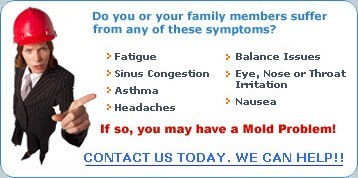Indoor Air Quality & Mold Inspections

A professional mold and indoor air quality evaluation and testing can provide answers. If you are considering a mold and indoor air quality inspection give us a call.
Our inspections provide a complete evaluation of the interior and exterior of your building conducted by trained and certified professionals using state of the art testing equipment and laboratory analysis. You will be provided a detailed report, explanation, and recommendations for remediation (if necessary).
Got LEAKS? Got MOLD? Got ALLERGIES?

What is Mold?
Mold is a type of fungus, comprising single-celled or multinucleate organisms that live by decomposing and absorbing organic material in which they grow, ie: mushrooms, molds, mildews, rusts and yeasts. Molds are decomposers of dead organic material such as leaves, wood, and plants. Molds sometimes infect living plants and animals. The spores and mold colonies are too small to see with the human eye without a microscope. When a lot of mold is growing on a surface, it often appears black, green, pink or purple. Mold growing on fabric is called mildew.

What does Mold need to grow?
Mold needs water to grow, without water it cannot grow. Mold also needs food, oxygen and a temperature between 40 and 100 degrees F. Mold needs a damp or wet organic material to grow on. Some molds can get moisture from the air. All they need is a relative humidity above 80%. Mold is virtually everywhere.

Why do I need to know anything about Mold?
Mold can affect your health. It can also damage or destroy building materials. Molds sometimes make powerful chemicals called mycotoxins. Unfortunately, some of these make people sick. It is possible for hidden mold to cause mold allergies in your building.
We do not do remediation work, that would be a conflict of interest!
A+ is strictly an inspection and testing company. We highly recommend an inspection and lab test before paying any money for remediation. If it is discovered that you need remediation, we will provide a list of certified professional companies that you may have the option to choose from. In the event remediation is necessary, always have a clearance test performed, to ensure your work was done correctly.
What does a 1st level mold inspection consist of?
- A visual physical inspection of the building inside and out, looking for any signs of mold and/or moisture intrusion (around doors and windows, and any possible plumbing leaks, etc.)
- A visual inspection of the heating/air conditioning system
- Examination of the filtration, the return, and the ducts
- Air, swab, or tape sampling for laboratory analysis
- Inspector compiles the on-site inspection along with certified laboratory results to provide the finished report
See Our Standards of Practice for a complete list of everything
Choose from 7 levels of inspection:
- Mold Inspection & testing – Visual inspection with mold sampling (swab, lift tape, inner wall, air cassette)
- Mold Inspection with thermal infrared – Visual inspection, infrared scanning inside & out of the building, with mold sampling (swab, lift tape, inner wall, air cassette)
- Mold Inspection, thermal infrared scan, mold sampling & Allergen sampling (pollens, dust mites, cockroaches, pet dander or biological pollutants)
- Mold Inspection, thermal infrared scan, mold & allergen sampling plus scanning for the presence of VOCs (volatile organic compounds).
- Indoor Air Quality Evaluation with carbon monoxide, carbon dioxide, temperature, relative humidity, absolute humidity, dew point, and air exchange rate are logged and charted for detailed analysis.
- Indoor Air Quality Evaluation Plus VOC testing using sorbent tubes to measure parts per million of specific volatile organic compounds.
- Suma canister or photoionization detector (PID) testing for on-site air sample collection and laboratory testing of volatile organic compounds.
What does an indoor air quality evaluation consist of?
- A visual physical indoor inspection of the building including looking for potential moisture intrusion
- Measuring, logging and comparing air quality outside and indoors. Measuring the temperature, relative humidity, dew point, carbon dioxide, and carbon monoxide levels
- Measuring and logging particulate matter in the indoor air, and sorting according to size. (The size indicates what it is, and points the inspector in the direction of the problem source. Is it mold, pollen, household dust, dust mite, cockroach, animal dander, smoke, bacteria or virus.)
- Measuring for combustible gases (such as methane, butane, propane. freon, etc.)
- Measuring for VOCs (volatile organic compounds) such as: acetone, ammonia, benzene, formaldehyde, chlorine, ethanol, toluene, vinyl chloride with a photoionization detector
- Sampling of contaminates for laboratory analysis
- Inspector compiles his report based on his on-site investigation along with the certified laboratory results

We can also test for:
- Asbestos
- Biohazards
- Formaldehyde
- Lead in paint
- Lead, chemicals, bacteria & Radon (in air, soil & water)
- Legionnaire’s disease and sick building syndrome
- Allergens
- Animal Pet Dander
- Bed Bugs
- Cockroaches
- Combustible Gases
- Carbon Dioxide
- Carbon Monoxide
- Dust Mites
- Formaldehyde
- Lead
- Legionella
- Meth Lab
- Molds
- Multiple Chemicals
- Pollens
- Radon
- Volatile Organic Compounds (VOCs).

